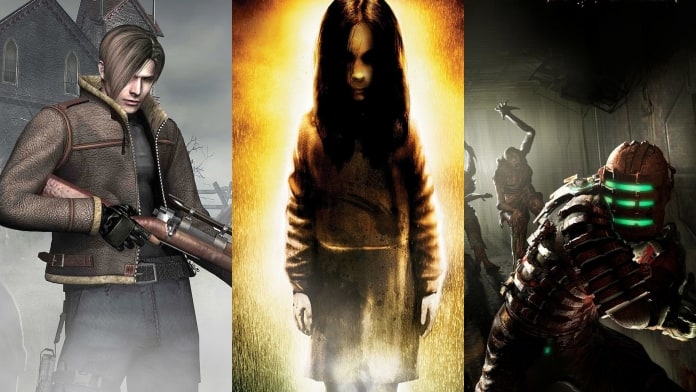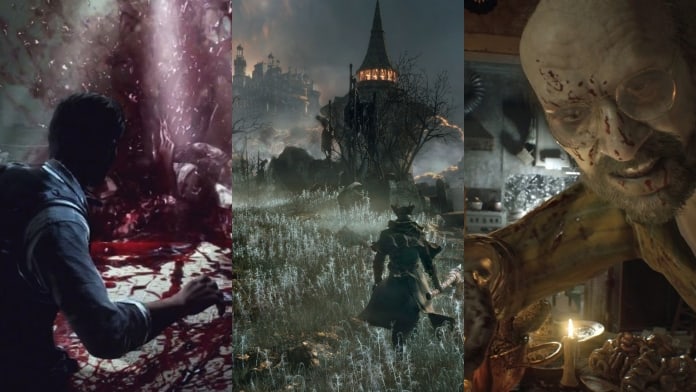Silent Hill 2‘s triumphant success started the so-called renaissance of horror-themed video games. While followers had to say goodbye to some really astonishing classics, they were graced with some new innovations. Survival horror was still popular, with games like Siren, Fatal Frame, and The Thing continuing the tradition established by Capcom. However, psychological horror became the current aim everybody’s profiting off, and one unfortunate game attempted to replicate what Konami’s franchise started out. Silicon Knights would produce a title that got a cult following equal to that of Silent Hill.
Eternal Darkness: Sanity’s Requiem, released in 2002 as a Nintendo Gamecube exclusive to universal acclaim. Though successful critically, financially, it failed due to its exclusivity. A small yet significant game-changer, Eternal Darkness, messed with viewers like nothing before. The gameplay was replicating the feel of older Resident Evil titles, but with a new addition, the sanity meter. Deleting of saved data, fake crashes, and characters’ death, all meant to trigger fear in those who played it. Truly a diamond in the rough, and while it would fail in terms of sales, it would inspire future developers to experiment.
Konami would still continue to publish sequels to their beloved franchise. But with every subsequent release, the team would slowly dissolve. The third title would already show cracks, and the fourth one finally divided both the developer and the audience. It was apparent that Silent Hill would never reach the level of success it once did, and after the development shifted to Climax Studios, it would plummet lower than ever before. This would be a perfect chance for its rival to steal the crown.
A Blend of Action and Fear
2005 would be a defining moment for Capcom. It would venture into the hall of fame, and claim the crown as one of the best horror games of all time. Resident Evil 4 would place its main protagonist in a nightmarish Spanish village, instead of a zombie apocalypse. Way back in the ’90s, Leon S. Kennedy would face waves of zombies and mutants, but never before did he go up against rural peasant. Adopting an over the shoulder view, instead of a fixed camera, Capcom introduced a feature that would be utilized outside of horror. All the elements were back from the previous titles but modified to fit more modern standards.
It was at this point that the term action-horror was born. A subgenre that many games would pick up, most notable the FPS genre. Much like in its previous decade, FPS games never stopped pushing the boundaries of shooter releases. Doom 3 would see a sort of reboot of the established series, while Condemned: Criminal Origins would create new ones. In between them all, First Encounter Assault Recon was born. FEAR, as it was known, turned its AI to perfection, as the enemies changed tactics depending on the player’s movement. This was all accompanied by gloomy corridors, a sense of dread, and a little girl, Alma.
Elements from all of these games would eventually split apart and be used by other studios. Visceral Games would take the over-the-shoulder perspective, and revisit the cosmos, with Dead Space. Once again, the player’s role was an ordinary man, or in this case, an engineer. However, he wasn’t a super-soldier, and his means of defense were limited against the foul Necromorphs. Issac Clark’s single tool of protection was a plasma cutter, and while it can’t kill efficiently, it could cripple them enough for an escape. A bold attempt, but ultimately a futile one.
Zombies, An Overstayed Trend
New forms of terror were flooding the market, and so with new innovations, the need for old ones to die out came to be. But one trend was committed to staying way too long. It’s hard to imagine, that way back in the 80’s zombies saved the gaming industry, with the introduction of flesh eaters. Today, the media is overcrowded with them, yet two games manage to stand out in the sea of zombie titles. Dead Rising gave a fun spin on the classic Night of The Living Dead plot. A likable main protagonist, who was miraculously efficient with every tool in fending off the horde of the undead.
Many zombies in Dead Rising were much like in the movie, slow and could be taken out with such ease. A frantic approach, more chaotic, would emerge with Valve’s ‘Left 4 Dead.’ Four survivors, and a simple goal, to reach the end of the level in one piece. Casual multiplayer fun, coupled with different types of zombies to break the monotony. The Hunter, Boomer, Witch, Tank, Jockey, the list goes on. Each with their distinct abilities and personality, the fast-paced shooter caught the attention of many. Beloved for its simple gameplay, and multiplayer replayability, it would garner a sequel in the following years.
Other first-person shooters also began to play around with enemy variation. While not flesh eaters, Bioshock’s ‘Splicers’ were mindless humans created by an overdose. More and more, these sorts of hybrid-mutants were stealing the stage from zombies. Games like STALKER and Metro took abominations straight out of the Chernobyl Mythos. Inspired by Roadside Picknick, it would garner so much love, that it created an entire culture. Metro would be based on the book of the same name, so literature still played a big part in horror gaming.
Run and Hide
By this point, the player was always secure with a weapon or tool to use against the nightmarish monstrosities. However, what happens when the game decides to take it all away and pushes one to confront the monster. Penumbra, by Frictional Games, would be a taste test of what was to come. Focusing more on puzzle-solving and storytelling rather than action, Frictional would craft their masterpiece after Penumbra’s completion. Amnesia: The Dark Descent, would play with viewers much like Eternal Darkness did way back.
The plot was straight forward. Daniel, the main protagonist, finds himself in Prussian’s Brennenburg Castle with no memory of why or how he got there. The player is then tasked to help Daniel traverse the castle, all while encountering different monsters. While the game’s primary objective is to recover the protagonist’s memory, it doesn’t shy away from toying with the viewers, with its sanity meter. As the bar goes down, the player starts experiencing more and more terrifying hallucinations, and the monsters are more attracted to Daniel. A similar premise would be adopted with Outlast.
The setting was changed for a more modern one, as the game’s protagonist finds himself in a mental asylum, rather than a medieval castle. However, Outlast gave us a much more realistic depiction of fear. Mentally scarred people were a more present threat than a flesh-eating creature. In all of these titles, stealth plays a pivotal role, and it punishes those who dare to step out of their boundaries and confront the enemy. Equipped with a small source of light and a journal, the idea of escaping rather than fighting is more encouraged and would provide a better sense of fear. Much to the delight of many, these games would see an emergence with the success of one particular project.
Fiction and Fanfiction
Ridley Scott may never again capture the magic of 1979 ‘Alien,’ but Creative Assembly would give an astounding new entry with Alien: Isolation. Continuing the story of the original movie, focusing this time on Amanda Ripley, the daughter of Ellen Ripley. Isolated on the Sevastopol Station with a lone xenomorph, the experience soon becomes a big hunt or be hunted scenario. The same atmosphere and feel of the film, encapsulated with an original plot, fully introduced the rise of stealth horror. Both Amnesia and Outlast would be highly influenced by Alien Isolation and would maintain the new subgenre.
The current decade saw a lot of fiction being adapted into virtual form, and a graphic novel would get a similar treatment. Telltale Games would create an original plot set in the Walking Dead universe, which played out simultaneously with the novel’s story. Adventure games once again saw enormous innovation. Point and click was taking a backseat to multiple branching paths in terms of storytelling. Telltale would continue to replicate this formula for the next decade, and even though it was eventually the cause of their demise, at the time, it was a breath of fresh air.
Compelling stories always pulled in gamers more than anything, and online creepypasta would see a growth in popularity. Small stories like the Slenderman and the SCP Containment Breach became phenomenons on a global scale, and they both originated from a single person. Both got the same treatment, an adaptation on multiple platforms. This gave more creative freedom to the public, and soon, small indie titles would see much more success. SCP Containment Breach would especially spawn a large community that is updated to this day.
A Bright Future
The second half of the 2010s saw massive changes. Action was more present than horror, and franchises like Alone in the Dark and Silent Hill would completely die out. Tropes and trends were shoved in with the tone of action and gore, resulting in horror titles losing their unique flavor. The Evil Within would try to distance itself from action-themed horror titles. A new look, but a familiar feeling, Tango Gameworks gave hope that more future releases would return to the roots of horror.
Bloodborne would be a defining moment that would see a perfect blend of the two. Its frantic ‘action-packed’ gameplay and its gothic atmosphere perfectly merged in a symbiosis of two themes. A new take on From Software’s RPGs, one that became the most popular in the franchise. Bloodborne was ripped right out of gothic literature, much like its creatures. Deformed beasts, garnering a primal hatred and dark gift, taken straight from novels written by Bram Stoker. Action was always intended to be on the sideline and Resident Evil would remind the industry the importance of that.
After a small fall from grace, Resident Evil once again emerged with positive results. Resident Evil 7 and the Resident Evil 2 Remake corrected the many flaws the action-horror genre was suffering from at the moment. A step in the right direction, it would produce two examples for future developers to aspire to.
From small movie tie-ins to massive franchises that are even to this day considered gems, the history of horror games is truly a beautiful one. Credited for the creation of many fan-favorite series and a legacy that future generations can always look to for guidance. An experience that resonates with many, long after the controller is put down.
Make sure to check out part 1 and part 2 of this series if you haven’t already.
- The Importance of Clara Zetkin for International Women’s Day - March 8, 2020
- Tatsuro Yamashita aka The King of City Pop - March 1, 2020
- Samurai Jack: Battle Through Time Announced for 2020 - February 25, 2020






